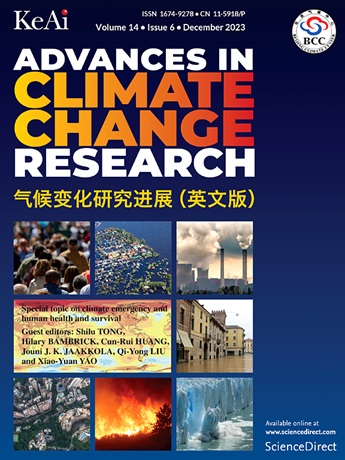Quantification of selected SDGs in the context of China's climate mitigation pathway
IF 5.2
1区 地球科学
Q1 ENVIRONMENTAL SCIENCES
引用次数: 0
Abstract
China has set targets for achieving peak carbon emissions and carbon neutrality, supporting the global climate change mitigation targets. Meanwhile, after the Sustainable Development Goals (SDGs) were established in 2015, China developed a national strategy for reaching them. This study aims to reveal the close relationship between energy transition, climate change mitigation and achieving SDGs. We presented the linkages between the climate change mitigation pathways and SDGs, by using the Integrated Energy and Environment Policy Assessment Model for China (IPAC). The energy transition pathways towards global net zero emissions and national carbon neutrality targets are presented as climate change mitigation pathways, with quantitative results of CO2 emissions, energy mix and electricity demand. The pathway explores the quantitative analysis of the contributions of the climate mitigation and energy transition on achieving selected SDGs. The results show that the energy structure would change remarkably in the energy transition pathways under the climate targets, with 65% drop of fossil fuels in 2060 compared with 2020 level, and the rapid increase in renewable and nuclear powers. According to the results of the selected SDGs, under the mitigation pathway for China, it could also pave the way for sustainable development in not only energy supply side (growing of clean and low-carbon energies), but also energy demand side, including industry (optimizing material/resource utilization efficiency), building (improving proportion of population with clean energies and technologies), and transport sectors (increasing traffic turnover). Besides the global climate effects (SDG 13), local actions and measures aimed at meeting climate mitigation goals also generate domestic co-benefits, supporting progress toward SDG 3 about good health (air pollutants will drop 39%–62% cross different pollutants by 2030 compared from 2015 level), SDG 6 about clean water (water demand for some industries will drop fast due to the technologies replacement and update), SDG 7 about clean energy (proportion of population with primary reliance on clean will increase to 65.9% in 2030), SDG 8 about economic growth (materials consumption per GDP will drop 62% in 2030 from 2015 level), SDG 9 about industry (transport volumes will increase 52%–258% by 2030 compared to 2015 level), SDG 11 about sustainable cities, and SDG 12 about responsible production and consumption (recycled materials will increase about 15% in 2030 from 2015 level). The close connections between China's climate mitigation strategies and these SDGs highlight the importance of integrating policies and measures related to both climate goals and SDG targets. Such integration implicates the potential to enhance synergies and lower the overall cost of implementation.
中国气候减缓路径下选定可持续发展目标的量化
中国制定了碳排放峰值和碳中和目标,支持全球减缓气候变化目标。与此同时,在2015年可持续发展目标(sdg)确立后,中国制定了实现这些目标的国家战略。本研究旨在揭示能源转型、减缓气候变化与实现可持续发展目标之间的密切关系。我们利用中国能源与环境综合政策评估模型(IPAC)展示了气候变化减缓路径与可持续发展目标之间的联系。实现全球净零排放和国家碳中和目标的能源转型途径作为气候变化缓解途径提出,并给出了二氧化碳排放、能源结构和电力需求的定量结果。该路径探讨了气候减缓和能源转型对实现选定可持续发展目标的贡献的定量分析。结果表明,在气候目标下,能源结构在能源转型路径上将发生显著变化,2060年化石燃料比2020年下降65%,可再生能源和核能快速增长。根据所选可持续发展目标的结果,在中国的减缓路径下,不仅可以在能源供给侧(增加清洁和低碳能源),还可以在能源需求侧(包括工业(优化材料/资源利用效率)、建筑(提高清洁能源和技术的人口比例)和交通运输部门(增加交通周转量)为可持续发展铺平道路。除了全球气候影响(可持续发展目标13),旨在实现气候减缓目标的地方行动和措施也产生了国内的协同效益,支持实现关于良好健康的可持续发展目标3(到2030年,不同污染物之间的空气污染物将比2015年下降39%-62%),关于清洁水的可持续发展目标6(由于技术的替换和更新,一些行业的用水需求将迅速下降)。可持续发展目标7关于清洁能源(2030年主要依赖清洁能源的人口比例将增加到65.9%),可持续发展目标8关于经济增长(2030年单位GDP的材料消费量将比2015年下降62%),可持续发展目标9关于工业(到2030年运输量将比2015年增加52%-258%),可持续发展目标11关于可持续城市,可持续发展目标12关于负责任的生产和消费(2030年再生材料将比2015年增加约15%)。中国的气候减缓战略与这些可持续发展目标之间的密切联系凸显了将与气候目标和可持续发展目标相关的政策和措施结合起来的重要性。这种整合意味着有可能加强协同作用并降低执行的总成本。
本文章由计算机程序翻译,如有差异,请以英文原文为准。
求助全文
约1分钟内获得全文
求助全文
来源期刊

Advances in Climate Change Research
Earth and Planetary Sciences-Atmospheric Science
CiteScore
9.80
自引率
4.10%
发文量
424
审稿时长
107 days
期刊介绍:
Advances in Climate Change Research publishes scientific research and analyses on climate change and the interactions of climate change with society. This journal encompasses basic science and economic, social, and policy research, including studies on mitigation and adaptation to climate change.
Advances in Climate Change Research attempts to promote research in climate change and provide an impetus for the application of research achievements in numerous aspects, such as socioeconomic sustainable development, responses to the adaptation and mitigation of climate change, diplomatic negotiations of climate and environment policies, and the protection and exploitation of natural resources.
 求助内容:
求助内容: 应助结果提醒方式:
应助结果提醒方式:


